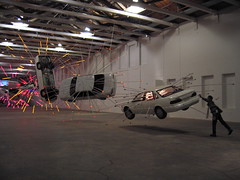Bionic Eyes
The CNET/BBC reports on the development of a bionic eye. The New Yorker had an article a year a so ago on the issue. Both pieces tend to concentrate on the techonological aspects, which are pretty interesting, such as, how does the visual cortex code stimuli from our eyes to create the image in our head. But neither delve deep into the psychological or emotional impact of regaining a sense after adapting to life without.
Brian Friel's play Molly Sweeney, which is based on an Oliver Sacks' casestudy, does, and results in less enthusiasm for sight restoration. One element is vast amount of brain power it takes to translate the sight of ring, with the word "ring", and the circular motion touching it creates. In short, it is overwhelming. I know in this case, the images are very crude, but still, the bioethical dillema persists. To see, then becomes the basic, elemental component of vision; it is recognition and incorporation with the other senses that is the real trick.
There's a fair amount of musing and joking about becoming cybernetic, but science fiction is becoming science fact. Thinking of all the consumer goods that are so poorly designed and thoughlessly made, and all the issues that come up with user interface, perhaps technologists should think deeper into how to intergrate these machines into our bodies.
Unrelatedy, there was all the hubbub over the new powerbooks having sudden motion detection, thus allowing for hacks to control video games by tilt. Anyone who grew up with video games can relate to the tilt that psychically helps move your avatar. Moving from a legacy interface (joysticks & control paddles) to an intuitive interface. Likewise the segway, President Bush excepting.
Labels: bionic, Macs, Miserable Failure, Oliver Sacks, sight, tech, Theater



0 Comments:
Post a Comment
<< Home